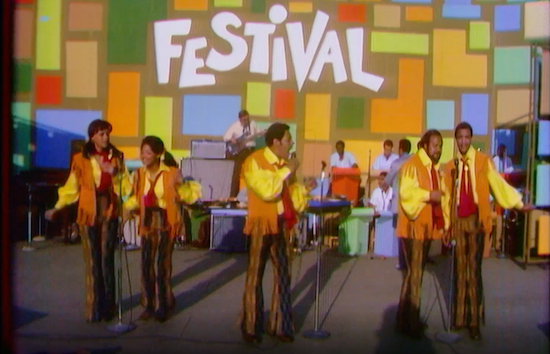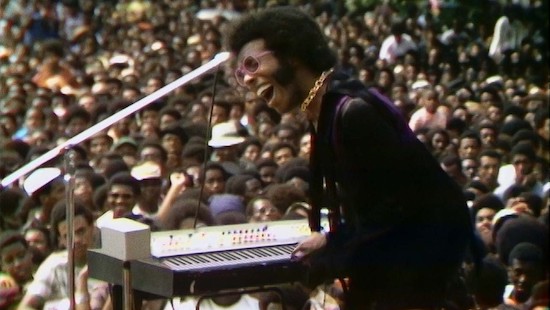A sweeping crowd packs into Mount Morris Park like sardines, heightened anticipation all but seen in the steam rising from the rainy heat. “Nobody ever heard of the Harlem Cultural Festival. Nobody would believe it happened,” an anonymous voice narrates. The buzz of the audience is loud, but the noise when a 19-year-old, short-haired Stevie Wonder takes the stage is deafening. Before a single note sounds, we know we’re witnessing history, and even more, history unseen – until now.
After Wonder slides his way into a rendition of The Isley Brothers’ ‘It’s Your Thing’, he mounts the drums, and it becomes clear why Ahmir “Questlove” Thompson – fellow multi-instrumentalist and beloved drummer of The Roots – chose the footage to establish his debut “jawn.” In a flurry of lighting-paced drum solos and ride-heavy jamming, interspliced archival clips and quotes colour in the historical context of the moment, starting local and, within a minute, broadening the scope to the Black consciousness revolution taking the country by storm. Stokely Carmichael, Bobby Seale, and others flash by in righteous indignation as Wonder grows more feverish on the kit, historical imminence practically bursting from the screen as the final introductory words crash over the footage: “We were creating a new world.”
The 1969 Harlem Cultural Festival took place over six Sundays between June 29 and August 24. It was free to all. On the fifth weekend, the weekend of August 17, Woodstock, with which it shared some talent (Sly and the Family Stone, who were not originally scheduled to play Harlem), was taking place 100 miles upstate. Meanwhile, in the city, legends Nina Simone and B.B. King were playing brilliant back-to-back sets – Simone in the headlining slot, of course. Everyone knows about Woodstock, but what about “Black Woodstock”?
Singer Tony Lawrence hosted, directed and produced the festival. New York City backed him, Maxwell House pitched in a hefty sponsorial sum, 300,000 people attended, and Hal Tulchin shot over 40 hours of footage. Tulchin shopped it around with the expectation of a bidding war, but was rejected by everyone. Confounded by the lack of interest in something with such popular appeal, yet still unable to sell, he put the footage in a basement where it would sit for the next 50 years, divorced from collective American memory. Now, having debuted at the 2021 Sundance Film Festival, it is the most recent example in a longstanding white tradition of Black erasure on screen.
Literary critic Parul Sehgal traces the modern concept of the word “erasure” back to the academic realm, where it is “used to describe how inconvenient people are dismissed, their history, pain and achievements blotted out.” The concept of erasure asks the questions: “Whose stories are taught and told? Whose suffering is recognized? Whose dead are mourned?” Or, in this case, whose triumphs are celebrated?
As Summer of Soul’s extended title – (…Or, When the Revolution Could Not Be Televised) – points out, America has a nasty track record of suffocating Black history, which is not to be confused with an innocent record of passive omission. The Harlem Cultural Festival, like so many pivotal Black moments, was actively ignored by white buyers, white history (e.g, Woodstock) rising to even greater cultural prominence in its place. Questlove, however, is one of countless artists on the frontlines of the ever-galvanizing fight to re-canonize the Black perspective in American history.
For journalists, contributing to the mass spread of new information that is canonization might look like Daphne A. Brooks’ (re-)unveiling of the festival for the New York Times. For artists, it might look like Kehinde Wiley’s peerless depictions of Black folks in historically white bourgeoisie styles. For filmmakers, it might look like Ava DuVernay’s exposé of America’s poisoned prison industrial complex 13th, or her piercing indictment of the criminalization of the Central Park Five, When They See Us, or Steve McQueen’s Small Axe anthology – which confronts the erasure of Black history in England, and, in doing so, presents a time, place, and culture that, up until 2020, was all but unknown on screen. Or, now, Questlove’s Summer of Soul, a masterclass in the art of weaving Black history back into the collective American consciousness.
Questlove is always filling in historical context, aware that any successful attempt at canonization must be in conversation with the histories people do know. Kennedy was assassinated in ‘63, Malcolm X in ‘65, Martin Luther King, Jr. in ‘68, Robert Kennedy only two months later. Nixon reigned over impoverished minorities that hated him. Vietnam was stealing a disproportionate number of Black and Brown children from their homes, the military using the oppressed as artillery because they lacked the socio-economic resources to fight back. Heroin addiction had escalated into a full-scale epidemic. The riots of April ‘68, prompted by the murder of MLK, were the worst city had ever seen, and that energy was still sizzling on the sidewalk in the summer heat.

The fest, given a makeover in its third year, was intended to quell rage – or, in other words, to keep New York City from going up in flames. However, the event didn’t end up being a distraction from the pain at the heart of the revolution so much as it was an expression of it, a communal and spiritual catharsis. “We couldn’t afford therapy,” Reverend Al Sharpton explains on-screen. He says music “was the therapy for the stress and pressure of being Black in America.”
Imagine Nina Simone breaking from her piano as she prompts the crowd with a fiery poem from David Nelson: “Are you ready Black people?” Cutting through the bullshit, she reads off more questions. “Are you ready to smash white things, to burn buildings, are you ready?” she cries. “Are you ready to kill, if necessary?” She seems only a half-step away from performing exorcisms on the white cops lining the stage ten feet in front of her. The audience roars between each query, and suddenly there is less mystery around why the white powers that be refused to air the footage. But it wasn’t just Simone.
The synthesis of fury, mourning, defiance, and hope in her music is unparalleled, but it was present in different ways across every act, from Reverend Jesse Jackson’s recounting of MLK’s last words to saxophonist Ben Branch, who plays behind Jackson on stage, to Sly and the Family Stone’s anthem of unity, ‘Everyday People’, to Dorothy Morrison and The Edwin Hawkins Singers invigorating choral arrangement on ‘Oh Happy Day’. It was contagious and mobilizing, a threat to those unwilling to change. And the coalescence and strength of the liberation movement was on display in the crowd – Black people from all different backgrounds unified in the hub of cultural cross-sections that was, and is, Harlem.
Showcasing that diversity, the performers ran the gamut from Motown to Mississippi blues to gospel to psychedelic R&B to Afrobeat to avant-garde jazz to Afro-Cuban rhythms to early Afrofuturist pop. But they all had one thing in common: soul. This was universal freedom music, sonic emancipation that bled into the bones. Questlove could have let us just watch the concert, and I sincerely mean that, but he takes the act of canonization one step further by offering the present-day perspectives of the artists that played, who tell new stories reaffirming the historical significance of the event.
The Fifth Dimension had a #1 hit with ‘Aquarius/Let the Sunshine In’, but they were sick of fielding claims of Black abandonment due to their white sound. “How do you colour a sound?” Marilyn McCoo asks, moments before we see tears stream down her and Billy Davis Jr. ‘s faces as they watch the footage of their set for the first time. They were elated to play Harlem because it was an opportunity to show the Black community that they weren’t “sellouts” to white commercialism. Questlove’s approach also informs iconic historical moments from the Black perspective – the summer of ’69, a particularly momentous season in US history.
On July 20, while The Staple Singers were playing, Neil Armstrong was getting ready to steal the show with “one small step”, but as Summer of Soul shows, Harlem didn’t care. It isn’t news that Black America saw the moon landing as an extraneous federal expense that could’ve and should’ve been directed toward impoverished minority communities and broken social systems. But one wonders how much more prominent that perspective might have been in the American consciousness – and, in result, how much more white attention would’ve shifted to the Black cause – had the image of a sea of moon-indifferent Black folks sunken into pop culture or the education system, or surfed across screens, as it soon will.
Addressing the disease of the Uncle Tom trope in film, Los Angeles civil rights attorney Loren Miller wrote: “The cumulative effect of constant picturization of this kind is tremendously effective in shaping racial attitudes. Hollywood products are seen in every nook and corner of the world. Millions of non-residents of the United States depend almost entirely on the movies for their knowledge of [Black] life.” That was in 1934, before everyone had a screen in their hand, another on a wall, and another on a desk.
While the internet now provides a near infinite number of ways for people to learn about other lifestyles and perspectives, the crux of Miller’s statement still rings true, and its poignancy draws out what makes Summer of Soul such a glowing achievement in the process of re-canonization: millions of people will see it. As Miller and Questlove both understand, the responsibility cannot rest solely on historians, writers, or community organizers. In a world dominated by media, on-screen circulation is the most effective mode of re-canonization.
Black music is as prominent a piece of American culture as Bob Dylan or Janis Joplin, whose voices were shaped by the gravely tonalities of the Blues, of which B.B. King and Mahalia Jackson’s charcoal vocal cords are the gold standard. Questlove’s work of cinematic historiography is a magnificent, compelling account of that truth, a fusion of the best concert films (e.g. Monterey Pop) and the most essential historical documents (e.g. Nat Turner: A Troublesome Property). He doesn’t just tell us about The Harlem Cultural Festival. He shows us the concerts, and lets us weigh the historical significance ourselves. Because, at the end of the day, Mavis Staples and Stevie Wonder don’t need anyone to explain what makes them important. They just need to sing. The rest is history.
Summer of Soul premiered at the 2021 Sundance Film Festival, and will be released this year via Searchlight Pictures.


